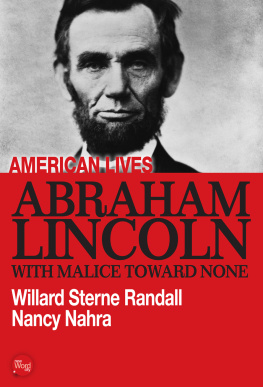Illinois Welcoming the World greets visitors in the Illinois State Capitol rotunda. It is a bronze casting that duplicated the original plaster figure that stood in the reception room of the Illinois Building at the 1893 Worlds Columbian Exposition in Chicago. Created by Julia Bracken, assistant to Lorado Taft, the bronze was dedicated on May 16, 1895, as a permanent memorial of the part which the women of Illinois took in the great Exposition. (Courtesy of Heather Hayes.)
On the cover : February 12, Abraham Lincolns birthday, is a special day of celebration in Springfield. On February 12, 1935, the fledgling American Legion made its first annual pilgrimage to Lincolns tomb. Among the dignitaries present for the ceremonies were Gov. Henry Horner; national commander of the legion Frank N. Helgrano Jr. of San Francisco; president of the legion auxiliary Mrs. A. C. Carlson of Willmer, Minnesota; and Springfield mayor John W. Buddy Kapp. (Courtesy of Sangamon Valley Collection, Lincoln Library.)
This book is dedicated to the countless amateur and professional historians, artists, and Lincoln buffs who have made and continue to make Springfield such an interesting and exciting place to live and work.
ACKNOWLEDGMENTS
We could not have brought this book to publication without the assistance, support, and encouragement of numerous institutions, individuals, and friends. We are grateful to many local historians whose research and writing helped us bring our stories to life.
We wish to thank our editors at Arcadia Publishing, Ann Marie Lonsdale and Jeff Ruetsche, for guidance and encouragement. Thanks also to our Arcadia production editor Heather ONeal.
We are especially grateful to the following fact checkers who caught some potentially embarrassing mistakes and typos: George Atkinson, Michael Dunbar, Linda Garvert, Keith Housewright, Mark Johnson, Curtis Mann, and Mark Sorensen.
We also want to thank Jo Ann Alessandrini, Jennie Battles, David Brady, Doug Carr, Joanie Caselton, Steve Dyer, Jim Edwards, Roberta Fairburn, Bill Furry, Jeff Garland, Amanda Gleason, Pat Glenn, Jim and Jan Grimes, Susan Haake, Kathryn Harris, Jim Hawker, Heather Hayes, Ross Horne, Nancy Huntley, LuAnn Johnson, Elena Kezelis, Mike and Kathy Klemens, Amanda (Londrigan) Staab, Rabbi Barry Marks, Linda Medlock, Jerry Melton, Mary Michals, Ken Mitchell, Thomas OBrien, John Paul, Taylor Pensoneau, John Popolis, Lindsey (Price) Harney, Paul Riemer, Kathie Sass, Tom Skelly, Chris Smith, John Standish, Richard Stone, Marianne Stremsterfer, Talon Thornton, Nancy Travis, Mark Whitlock, Graham Woerner, Harold and Jackie Wright, Judy Wright, and Nan Wynn.
Unless otherwise noted, all images are from our collection.
INTRODUCTION
Springfield, Illinois, is a city of contrasts. Nowhere is that more evident than in its history. Abraham Lincoln, the Great Emancipator, spent 24 years of his life in the city. Yet in 1908, race riots killed seven people, ruined 40 homes, and destroyed 24 businesses within 48 hours. Susan Lawrence Dana, a local socialite, provided an open check book to Frank Lloyd Wright in 19021904 to design and build an opulent home for entertaining. Just a few blocks south of Danas home was the Home for the Friendless. Founded in 1863, the orphanage cared for thousands of homeless and needy children. These contrasts and much more are documented in the citys plaques and artworks.
This book uses contrasting elements to tell Springfields diverse story. The collection reveals well-known facts and lesser-known details, notable events and mundane incidents, famous historic figures and Springfields ordinary citizens. The depicted works themselves encompass styles ranging from classical monuments found in Oak Ridge Cemetery to contemporary sculptures installed on university campuses. They have been created by world-renowned sculptors as well as emerging artists.
The vision of the authors is that this collection will serve three functions: a record of history, a guide for exploring Springfield, and a springboard for future research. Because Lincoln dominates the Springfield historic scene, many of the images relate to our 16th president. However, a wide range of other themes and individuals are also included. For example, Oak Ridge Cemetery, best known as Lincolns final resting place, also has monuments honoring soldiers from the Revolutionary War, the Civil War, World War II, the Vietnam War, and the Korean War. Springfield-native Vachel Lindsay, famed poet and singing troubadour of the early 20th century, is honored with a gravestone in Oak Ridge Cemetery and a plaque on his home. A plaque on the Elijah Iles House, Springfields oldest house, memorializes Iles, who was one of the citys earliest settlers. Relatively new monuments to those who died on September 11, 2001, stand on the capitol lawn and the Capital Area Career Center.
To aid the reader who chooses to seek out a statue, monument, or plaque, most captions describe the location of the image they accompany. Springfields Sculptures, Monuments, and Plaques is written so that the armchair historian and the city explorer can discover the rich and varied record of Springfield through the eyes of those who have chosen to preserve history through artworks and plaques.

Just to the left of the entry door of the Maid-Rite restaurant at Jefferson and Pasfield Streets is a plaque that reads: This property has been placed on the National Register of Historic Places by the U.S. Department of the Interior Circa 1924. Opened in August 1924, the diner still provides in the original building drive-thru service (an innovation in 1924), trademark Maid-Rite sandwiches of loose ground beef with spices, and homemade root beer. In 1926, the Springfield Maid-Rite evolved into one of the first restaurants in the country to become a franchise. The franchise currently operates more than 70 restaurants nationwide. Except for the addition of a larger dining room space, the building, menu, and service are much the same as they were in 1924 in the shadow of the Illinois State Capitol.
One
WHERE GOVERNMENT LEADS ILLINOIS STATE BUILDINGS
Springfield is the third Illinois city to serve as the state capital. When Illinois was admitted to the Union in 1818, Kaskakia became the first capital. In 1820, the government was moved to Vandalia. Through the efforts of a group of nine legislators from Sangamon County, led by the young Abraham Lincoln, the 18361837 Illinois General Assembly named Springfield the third capital city. The state government began functioning in Springfield in 1839. From 1840 to 1876, the seat of government was the Greek Revival building at the center of downtown that is now known as the Old State Capitol.
On February 24, 1867, the 25th Illinois General Assembly authorized the construction of the present capitol building. Twenty-one years later, in 1888, the structure was completed. It housed the judicial, executive, and legislative branches as well as government departments, regulatory boards, military leaders, three museums, several libraries, and the states archives. The first statues that adorned the building were the large memorial to Pierre Menard on the Second Street lawn and sculptor Leonard Volks Abraham Lincoln and Stephen A. Douglas statues in the east hall of the building.




















